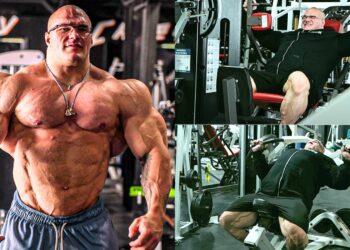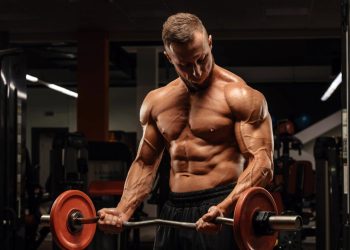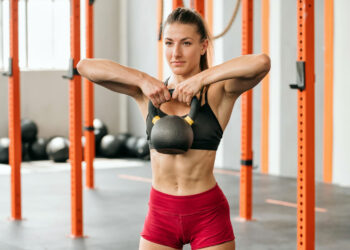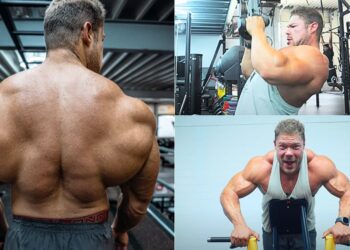The kettlebell alternating row is a back exercise that offers training variety, aka the spice of life. Rather than using dumbbells or cables all the time, using the uniquely shaped kettlebell may provide some stimulus that many aren’t used to.
In this guide, we’ve discussed the muscles worked, benefits, and you’ll find tips, variations, and a sample workout using this movement.
Muscles Worked
While the back muscles are the focus when performing the kettlebell alternating row, many would be surprised to know that several muscle groups are involved.
This can be a great thing because you’re able to stimulate multiple muscles groups and therefore, improve muscular and strength development in less time.
We’ve included short descriptions of each muscle group involved in this movement.

Infraspinatus
The rotator cuffs are a group of muscles and tendons encasing the shoulder joint that include the infraspinatus supraspinatus, teres minor, and subscapularis muscles. Together they keep the top of the upper arm in the socket of the shoulder and contribute to the mobility and stability of the shoulder joint. The infraspinatus can laterally and externally rotate the arm at the shoulder.
Level Up Your Fitness: Join our 💪 strong community in Fitness Volt Newsletter. Get daily inspiration, expert-backed workouts, nutrition tips, the latest in strength sports, and the support you need to reach your goals. Subscribe for free!
Latissimus Dorsi
The latissimus dorsi or lats for short is a broad, flat muscle that spans the lower posterior thorax. It works with the teres major and pectoralis major to adduct and medially rotate the humerus, and it helps to extend the humerus with help from the teres major and the sternal head of pectoralis major. The lats are also involved in moving the trunk forward and upward when the arms are positioned overhead.
Teres Major
A thick muscle in the back, teres major medially rotates and adducts the arm (pulls it inward toward the centerline of the body) and stabilizes the shoulder joint for proper movement. It’s not a rotator cuff muscle like it’s minor sibling.
Teres Minor
Unlike its bigger sibling, the teres minor is a rotator cuff muscle along with the other rotator cuff muscles. Rotator muscles stabilize the glenohumeral joint for optimal function. But the teres minor has specific functions which include lateral, or external rotation of the arm where the shoulder is.
Transverse abdominis
Not to be confused with the rectus abdominis, the transverse ab muscles are deeper and they draw the belly button into the spine to keep it stable and rigid to support full body activities and lifting.
Trapezius Lower Fibers
Rows are a traps building exercises despite not being a common exercise of choice for these muscles. The lower fibers pull the scapula down and assist the upper fibers to pull the scapula upward.
Trapezius Middle Fibers
The middle child between the upper and lower fibers, the middle trapezius fibers, adduct (retract) the scapula.
Brachialis
The brachialis is a less popular muscles to the biceps that it sits beneath. It starts from roughly halfway between the upper arm and extends down past the elbow joint. It’s known to be a pure elbow flexor. Any type of pull focused arm exercise will work the brachialis.
Brachioradialis
The brachioradialis is the lateral forearm muscles located on the same side of your knuckles. They bend your arm at the elbows and twist the forearm to perform supination and pronation.
Deltoid Posterior
The deltoids posterior is one of three muscles that create the main shoulder muscles that move the arm in various directions. The posterior or rear deltoids are the head that pull the arms back behind you.
Pectoralis Major Sternal Head
Located at the sternum or lower chest, its own sections of fibers has specific functions that include transverse flexion and adduction, internal rotation, adduction, and extension of the shoulders. Additionally, the lower chest muscles can downwardly rotate, depress, and abduct (movement away from the center) the scapula.
How To Do The Kettlebell Alternating Row
While there’s nothing particularly complex about this exercise, there are proper and not so proper ways to do it. While anyone can pick up a pair of kettlebells and do rows, using bad form can cause injury, pain, and lessen the benefits of this exercise.
Therefore, we created step-by-step instructions to ensure you’re at least doing it in a safe and effective manner. But we do understand that more experienced exercisers may have their own technique and that’s totally fine.
Choosing a weight
If you don’t have much training experience, then you’ll want to choose lighter weights to start to ensure you get the form down before ramping up the poundages.
While simply a suggestion, most beginner women may want to start with 12 lb kettlebells or lighter while men may want to start with no more than 25 lb kettlebells and sometimes less is ideal.
Due to its unique design, it could take a little getting used to and especially if you’re only used to dumbbells and more common training tools.
Exercise instructions
- Place the kettlebells on the floor in front of you about a foot apart from each other.
- Position your feet wider and roughly shoulder-width apart evenly in front of and close to the kettlebells.
- Feel free to slide the kettlebells into place until you find a comfortable rowing position, so long as you’re maintaining good form and you’re not leaning far forward.
- Keeping your back straight, chest up, and core tight, bend your knees, push your hips back and hinge forward at your hips until your back is parallel to the floor or slightly higher.
- Pick up the kettlebells and re-set your form. You want to make sure your back is straight, and your shoulder blades back.
- Pull/row one kettlebell in line with but slightly past your lower chest. As you lower that kettlebell, row the other one and continue alternating rowing the kettlebells.
Here’s a video example…
Kettlebell alternating row tips
- Avoid rotating and twisting as you’re rowing the kettlebells.
- Do not allow your knees to cave in during this movement.
- The kettlebell alternating row is ideally performed with the feet positioned wider than the arms during the exercise. Therefore, you’re rowing with the arms closer together. This is also called the gorilla row. Although, you can do it with the arms on the outside of the legs if preferred.
- While you can keep the movement going by not touching the kettlebells to the ground, you can also alternate placing each kettlebell down during the set. Putting the kettlebell down is ideal for those with less than optimal lower back strength as it provides support during the rows. The supported version may also be better for handling heavier poundages.
Variations and Alternatives
The kettlebell alternating row is a phenomenal exercise and back variation. However, we also like these variations and some people may prefer alternatives of which we’ve also included.
Dumbbell alternating row
Kettlebells are certainly becoming increasingly more popular and most gyms and many home gyms are equipped with this versatile and functional training tool. However, dumbbells are more common and some people are more used to using them.
Level Up Your Fitness: Join our 💪 strong community in Fitness Volt Newsletter. Get daily inspiration, expert-backed workouts, nutrition tips, the latest in strength sports, and the support you need to reach your goals. Subscribe for free!
You can do the alternating dumbbell row and reap similar benefits. The only difference is there may be a little less core activation and carryover from the functional aspect of training using kettlebells. But if your goal is to just build solid back mass, you can never go wrong with dumbbells.
Kettlebell bent-over row
Instead of alternating arms, you could row both arms at the same time. And this way, you can more easily identify if there’s a weaker side that needs to be brought up to par.
While it’ll still develop strength and muscle, row slowly and pay attention to how each side is performing. Symmetrically strength is important for proper development.
Kettlebell single-arm row
One-arm kettlebell rows are a good option for lightening up the weight even more and using a full range of motion to really get a pronounced contraction of your back muscles.
But it’s also good for functional training and identifying and fixing left to right strength imbalances. If you’re weaker on one side, you can perform an extra rep or two to even up the strength on both sides.
Additionally, it’ll utilize more of your core which is good for development and you can more easily transition into a swing or clean if you wanted to mix things up a little.
Kettlebell renegade row
The renegade row is a very functional exercise that many don’t do, probably because it’s a little unconventional and a bit harder to do than other, simpler row variations. Although, many avoid it because they don’t feel it has any use in their training regime.
But it does offer benefits including working your back, biceps, rear delts, core, wrist strength, and total-body stability.
Not to mention, using a pair of kettlebells as opposed to dumbbells will require more attention to detail and balance.
Chest-supported kettlebell rows
Another good option is to sit chest down on an inclined bench and do rows this way. It’ll take your back out of the movement and prevent any cheating.
The 12 Best Kettlebell Back Exercises
Kettlebell Alternating Row in Your Training Routine
The kettlebell alternating row really is an exciting exercise to introduce in your training if you’ve only been using dumbbells. It also makes for an excellent addition to a functional strength training workout.
Doing the alternating version may mean using a little lighter weights but you can do the supported variation and up the weights to make it an even better strength builder.
How you include it depends on your preference but we can certainly recommend some effective training methods.
Strength
For strength, it’s best to perform reps in the 3-5 rep range.
Hypertrophy
For hypertrophy or a focus on maximizing muscle gains, the 6-8 rep range is ideal.
Muscular endurance and hypertrophy
If you want to burn more calories, improve your conditioning or physical fitness, but still build muscle without having to use heavy weights, aim for the 15-25 rep range.
Some other methods that you can use to include this exercise are supersets, where you perform two exercises back to back, a circuit where you do rounds of multiple exercises with little to no rest in between, and even HIIT or high-intensity interval training routines.
Really though, there are many different ways you can benefit from this movement.
Try The Best 5 To 10-Minute Workouts for Time-Pressed Exercisers.
Up Your Back Development With The Kettlebell Alternating Row
If you’re not convinced that the kettlebell alternating row deserves a spot in your back workout routine, then you’ll just need to try it out for yourself.
It makes for a great alternative to dumbbells and other training tools and the kettlebell is a very functional training tool when used properly.
Interested in measuring your progress? Check out our strength standards for Clean, Dumbbell Row, Renegade Row, and more.








